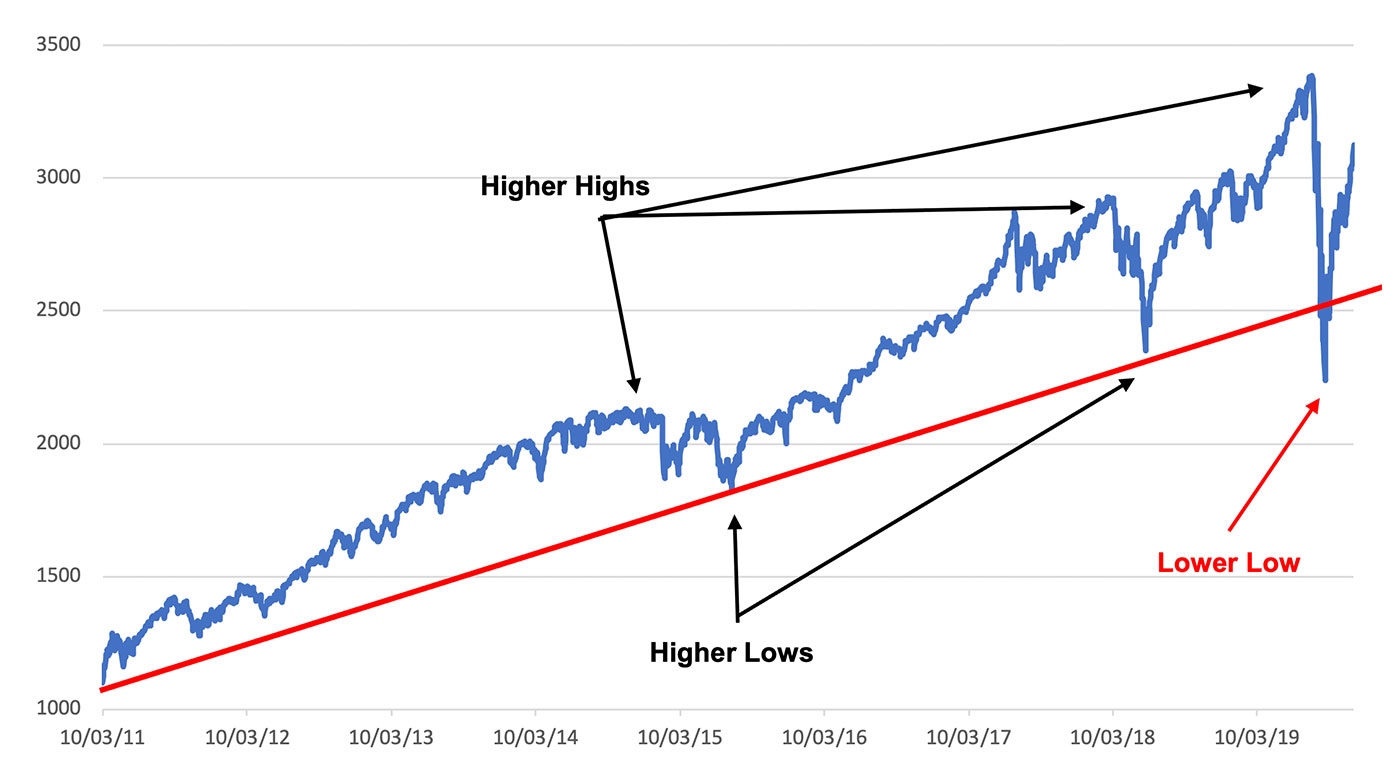

Or will it become a fatality of COVID-19?
The prognosis remains unclear, but we believe the bull market will return healthy and ready to run.
The big risk is that the economy will fail to respond significantly to the massive fiscal and monetary stimulus, some $6 trillion and growing. If economic stagnation becomes the new norm, then probabilities rise sharply for a secular bear both domestically and globally.
We believe the outcome will be vastly different.

Source: STIR Research, data through 6/3/2020
COVID-19 was, and still is, a black swan event that upended the secular bull market and caused major technical damage. Keeping in mind that secular bulls will be interrupted by corrections, the correction experienced in the U.S. equity market is concerning for several technical reasons:
- Secular bull markets are a series of cyclical bull and bear markets. But they are always moving higher, like a staircase, with higher highs and higher lows. That had been the case since 2011, until this March. The S&P 500 fell to a lower low than reached in December 2018. But it is not without precedent. In the 1949–1968 secular bull, the Dow fell to a lower low in 1962, and the S&P matched its prior low. But that did not signal the end of the secular bull. The lower low was followed by a new bull market and new highs with gains of 85% for the Dow and 80% for the S&P.
- The magnitude of the fall, -33.9% for the S&P, was unusually large for a cyclical bear within a secular bull. In the 1949–1968 run, the biggest drop was 28% in five cyclical bears. However, the 1982–2000 secular bull run was interrupted by four cyclical bears. The largest loss among those was 33.5%. Following that drop in 1987, the secular bull resumed, gaining another 582% over the next 12-plus years.
- The correction broke a trend line that had been rising for more than eight years. That is rare and unusual. The good news is that the dip below the trend line lasted only several days. Again, this is not without precedent. In secular bears, the trend line is flat, extending from its high, not to be broken until the start of a new secular bull market. In the secular bear market of 2000–2011, the S&P traded above its old 2,000 high a total of 36 trading days in 2007, breaking slightly above its seven-year trend line. The breakout was shallow and short-lived. The secular bear resumed with a vengeance, losing 56.8% over the following 15 months.
It is important to note that many of the optimistic extremes normally present at the end of previous secular bull markets were nonexistent this time:
- Secular bulls end when optimism is at its peak. That was not the case in 2019 or early in 2020. Investors poured $600 billion more into bond funds than stock funds in 2019. That suggests that stocks were far from being overloved in this instance.
- P/Es rose during 2011–2019, but nothing close to the overly optimistic moves seen during previous secular bull peaks. At the end of the last secular bull in 2000, the S&P 500 P/E (price to trailing four quarters of GAAP reported earnings) was at 34.7 and had gained 270% over the 18-year bull run. In contrast, the S&P’s P/E has expanded by only 63% in the current secular bull, from 13.0 on October 2011 to 21.2 by February 2020.
- The market’s “risk premium” remains very bullish. The difference between the earnings yield (earnings/price) of stocks and the 10-year bond yield is the basis for determining the risk premium. Typically, stocks will have a higher earnings yield than bonds to compensate for the additional risk in owning equities. At the peak (the end) of the last two secular bulls, optimism was running high. Investors were throwing caution to the wind, bidding stocks up to extreme highs. The earnings yield was less than Treasury bonds, a negative “risk premium.” That was not the case early in 2020. The earnings yield was almost 5%, versus 0.65% for the 10-year note. Even with earnings expected to crater by 35% in 2020, the earnings yield with the S&P 500 at 3,000 would be above 3.0%. If the S&P 500 corrected significantly to 2,000, the earnings yield would rise to over 4.5%. In neither case does the risk premium for stocks go negative, as it has at the peak of optimism that marked the end of prior secular bulls.
“Every mega-boom has been the result of new innovations and triggers that will fundamentally alter the future”
— paraphrased from the book “Dow 85,000! Aim Higher” by Marshall Schield and Trent Schield
Back in 2012, when writing our book “Dow 85,000! Aim Higher,” we thought the triggers for the current secular bull were energy and reshoring. With the technological breakthrough in fracking, the U.S. was on pace to become a world leader in energy, natural gas, and oil. Companies would be attracted to doing business domestically, where the supply of energy would be dependable, abundant, and cheap—thus, reshoring within several industries versus the previous trend of offshoring.
Those two foundations for the secular bull have not changed. COVID-19 led to a massive disruption of supply chains. It further highlighted the fact that the offshore manufacturing of many critical products for the U.S., such as medical equipment, drugs, microchips, and many others, led to a risky dependence on foreign sources. That should change, speeding up the move to reshoring.
We believe that is very possible. The market generated a rare 90% breadth thrust on May 27, 2020. This is when 90% or more of the stocks on the NYSE close above their respective 50-day moving averages. There have been 12 previous occurrences going back to 1970. That covers five decades of challenging times, secular and cyclical bull and bear markets. The average S&P 500 advance six months after a 90% breadth thrust was 12.8%, and 19.3% over a full year. If today’s market matches the historical average six-month gain, it would be above 3,400 before Christmas and at record highs.
Editor’s note: After Mr. Schield wrote this article, the U.S. Bureau of Labor Statistics released the May employment report. The surprise addition of 2.5 million reported jobs led to further significant market gains, with the S&P 500 rising above 3,200 on an intraday basis. This represented a gain of about 46% from the March intraday lows.
 Marshall Schield is the chief strategist for STIR Research LLC, a publisher of active allocation indexes and asset class/sector research for financial advisors and institutional investors. Mr. Schield has been an active strategist for four decades and his accomplishments have achieved national recognition from a variety of sources, including Barron's and Lipper Analytical Services. stirresearch.com
Marshall Schield is the chief strategist for STIR Research LLC, a publisher of active allocation indexes and asset class/sector research for financial advisors and institutional investors. Mr. Schield has been an active strategist for four decades and his accomplishments have achieved national recognition from a variety of sources, including Barron's and Lipper Analytical Services. stirresearch.com
